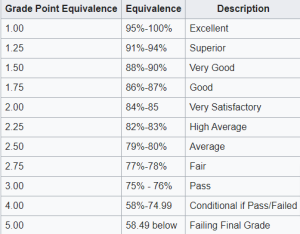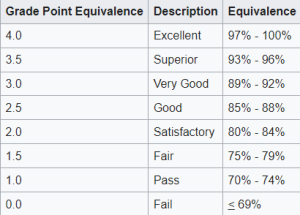New College Grading System in Philippines 2024

Contents
- New College Grading System in Philippines 2024
- Secondary School Grading System in the Philippines
- Higher Secondary School Grading System
- Comparing the Philippine Grading System with Other Global Grading Systems
- Overview of Grading Policies in the Philippines
- a) Types of Grading Scales:
- b) Minimum Requirement of Passing Grades:
- c) General Weighted Average (GWA):
- d) Percentage Qualification:
- e) Latin Honors Eligibility:
- f) Conditional Passing:
- g) Incomplete Grades:
- h) Department of Education (DepEd) Guidelines:
- i) Policies Across Institutions:
- j) Grade Recalculation Options:
- k) Letter Grades:
- l) Role of Grading Policies in Careers:
- FAQS
Knowing the diverse college grading system in Philippines 2024, I can feel the lack of uniformity around the institutions.
As an evolving player in the global academic market, the country employs various aspects of a grading scale that changes significantly depending on the institution.
Some institutions use a 4-point grading scale, whereas others rely on a 5-point grading system, creating a distinctive challenge for both students and educators. This developing method reflects the Philippine’s efforts to refine its education system while adapting to worldwide standards.
In this article, I will share my insights into what students and teachers are required to understand about the new grading systems in 2024.
New College Grading System in Philippines 2024
1. 4-Point Scale
Based on my experience working within educational institutions that rely on a 4-point grading scale, I have seen how this system, modeled after the U.S. framework, assures precision in evaluating student performance.
The scale ranges from 4.00, representing the highest grade, to 0.00 the lowest. Universities like Ateneo de Manila University (ADMU) and the University of the Philippines implement this system carefully, demanding accuracy in allowing academic achievements.
My involvement in advising students within these organizations has provided me a vast understanding of how this scale fosters both clarity and fairness in measuring academic progress.

2. 5-Point Scale
From my experience working with organizations that employ the 5-point grading scale, I have observed its traditional approach to evaluating academic performance.
In this, system, 1.00 represents the highest possible grade while 5.00 is the lowest, with 3.00 serving as the minimum passing mark. Institutions such as the University of Santo Tomas (UST) and Central Luzon State University (CLSU) rely on this scale to assess students’ achievements comprehensively.
Having guided students through understanding and improving their performance within this framework, I’ve gained a deep appreciation for the structure and rigor it brings to academic evaluation.

Secondary School Grading System in the Philippines
Exposure to a simple 5-mark marking scheme, which is very common in junior high and high school, came as an eye-opener to me.
A minimum passing mark, generally at 2.5 or the “C” range, establishes a clear baseline for academic excellence. As for scores exceeding 90, they signify excellent feats which indicate exceptional effort and understanding.
I have assisted teachers and students in dealing with this criterion, and I have seen how it promotes openness and pushes students toward excellence.

Higher Secondary School Grading System
Having worked alongside the Philippine College Grading System, I find it pragmatic to use both letter and number grades to measure students’ performance at all levels of study.
Designations exist for absences and incompletes meant to address most unique curricular situations in which students find themselves. Each institution determines its definitions for grading, thus providing both the complexity and the latitude.
A closer look at some of these grade calculators shows how tremendously useful they’ve been for students to compute their numeric grades and for them to know where they stand in school.
I have often assisted students in using this type of tool for such work, enabling them to know where they are on their degree path. Additionally, encyclopedic references on standard computing methods, in general, help to bring some clarity to the game and assist students in goal-setting.

Comparing the Philippine Grading System with Other Global Grading Systems
Grading systems in the Philippines and other countries differ in terms of scales, grading criteria, and interpretations. Here we will analyze the grading systems of the Philippines against those of the United States, the United Kingdom, and Australia.
In the Philippines, some universities have a grading system that ranges from 1.00 to 3.00 on a 5-point scale, with 1.00 being the highest and 3.00 being the lowest passing grade. A 4-point scale similar to the one used in the U.S. uses a grading system ranging from a highest of 4.00 to a lowest passing grade of 2.00.
By and large, the United States grade scale is divided into letter grades, starting from A plus all the way to F. A is considered the best, while D is the lowest passing grade.
In some schools, grades are awarded as numbers between 0 and 100, with 100 being the highest grade you can get and 60 as the lowest passing grade.
In the United Kingdom, GCSEs are graded from 1 (lowest) to 9 (highest), with 4 being considered a passing grade. For A levels, a letter grade scale is used, with grades from A-star (highest) to E (lowest).
In Australia, the grading system gives grades such as HD (High Distinction), D (Distinction), CR (Credit), P (Pass), and F (Fail). HD is the highest grade and P is the lowest passing grade.

Overview of Grading Policies in the Philippines
a) Types of Grading Scales:
Philippine universities and colleges run their processes using various grading systems-most common being 5-point (with 1.00 being the highest and 5.00 as failing) and 4-point (4.00 being the highest and 0.00 as failing).


b) Minimum Requirement of Passing Grades:
Under a 5-point system, obtaining a minimum score between 3.00 and 1.00 will be regarded as passing; under a 4-point grading system where a score lower than 1.00 indicates passing status, some schools apply this to 75%.
c) General Weighted Average (GWA):
GWA is a generic term that typically refers to a student’s general final academic performance expressed as the average in the course, and it is heavily weighted in considerations for graduation and retention.
d) Percentage Qualification:
Although percentage equivalents are included in either system in various institutions, these standards regarding large ranges of percentages respond flexibly to evaluate performance; for instance, 96%-100%=1.00 in the 5-point grading scale.
e) Latin Honors Eligibility:
Students with a high GWA stand a chance of being awarded Latin honors-Summa Cum Laude, Magna Cum Laude, or Cum Laude-subject to institutional policies.
f) Conditional Passing:
An INC (for Incomplete) is given to those who did not complete that particular term for some other reasons, and it must be addressed before they can receive a final grade.
g) Incomplete Grades:
Grading systems of all schools shall conform with national policies established by the DepEd or CHED to ensure the regulation of standardization therein.
h) Department of Education (DepEd) Guidelines:
The principle of all grading systems aims toward conformity with national policies promulgated by the Department of Education or Commission on Higher Education so that standardization is achieved.
i) Policies Across Institutions:
A few universities like the University of the Philippines (UP) and De La Salle University (DLSU) might have their unique grading scales or policies that align with their academic standards.
j) Grade Recalculation Options:
Learners have the benefit of retaking courses or petitioning for grade changes; this is especially common for prerequisite courses.
k) Letter Grades:
Some institutions, such as international schools, use letter grades (e.g., A, B, C) with numerical equivalents in line with international practices.
l) Role of Grading Policies in Careers:
Grading standards influence opportunities for scholarships, internships, and jobs, which serves to accentuate the importance of continuous student performance during a person’s period of education.
FAQS
1. What is the DepEd grading scheme?
Many countries including the Philippines, run a ‘standardized’ grading system to evaluate and assess the student’s academic progress, under the Department of Education (DepEd). The grading usually consists of letter grades and numerical equivalents.
2. What does a 1.75 grade mean in Philippine college?
Philippine colleges adopt a grading system that often translates numerical equivalencies for letter grades. A grade of 1.75 generally falls under the category of a Very Good grade. This translates to a grade point equivalence of inconsistently falling between the grades of 89-88%.
3. What does an A+, A, or B+ grade mean?
A+: Exceptional performance, typically 97-100%.
A: Excellent achievement, usually 90-96%.
B+: Very good level of performance, around 87-89%.
Keep in mind that grading scales may vary between institutions
4. Is a D considered a passing grade?
Yes, in most educational setups ‘D’ is considered a range of marks that does not necessitate a repetition of the course. However, the grading policies in various schools are different so it is advised that the students check the grading for passing policies.
5. To pass a class, what grade is necessary?
A: It is a norm that a grade of 60% or higher is deemed to be a passing grade. Consult your institution’s particular grading policies to confirm.
Grading in the Philippines fuses tradition and modernity into one system and offers options for traditional or modern methods of evaluation. The four- and five-point scales are used along with percentage equivalents and General Weighted Averages (GWAs) in the evaluation process, for fairness, flexibility, and compliance with international standards.
Conditional passing, possible recalculation, and eligibility for Latin honors are but a few of the policies that would highlight concerns about support to the student in the academic search for excellence.
The influence of grading systems is not limited to the classroom, but extends to the opportunities available to students, whether in higher education contexts, scholarships, or entry into their future careers.
With Philippine education taking to the stage of global education, grading policies will remain an inimitable byway to a competitive workforce ideally groomed.






